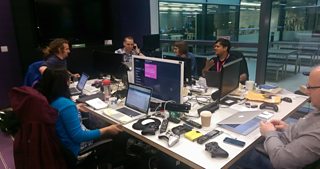Hi, I’m Technical Lead for the �������� iPlayer for TV Xbox One team that took the existing product and adapted it to .
��

Julia and the team working on creating the Xbox One application
The first part of the challenge was to create a slick automated build process to package up the normal codebase into an app which can run on the platform. This approach means that in one click we can take the latest version of the product and wrap it with the additional device-specific code required to produce a bona fide Xbox One app.
Once we completed the basics of the packaging process, we could build an initial version of the app and see it running on Xbox One. It really helped to have a usable version of the app from such an early stage as it gave perfect visibility to the progress we were making and the work that was left to do. Xbox One runs 1080p, a higher resolution than we previously supported, so the most striking problem was that the app did not fill the screen.
Once support for 1080p resolution had been added and all of the standard app features were in a stable and working state, the next phase was to integrate into the wider Xbox One ecosystem.
This included:
• hooking up with the user sign-in process,
• enabling programmes to be linked to from Bing search,
• providing support for Xbox's second-screen "SmartGlass" companion app,
• and the big one - voice control.
On the other devices on which our TV apps run, user interaction is based on 5-point navigation (the five buttons: Up, Down, Left, Right and Enter). The Xbox One app allows the user to navigate just by using their voice. This works by providing a voice command, which can be used to activate an item. So the voice commands work like mouse-click or select on a remote control.
Since support was not already present for mouse point and click interaction, this was the first step. One addition that was required to support this was a new mechanism to allow navigation through the menus. The 'Next Page' buttons were added to show the next set of items in a menu, where previously it was only possible to scroll through the items one at a time via the navigation keys.
With click support in place, the next step was to make use of Microsoft's voice Application Programming Interface (or API) which does the clever work of allowing voice commands to behave like a mouse click. At the same time, we worked to change certain aspects of the visual design to make the application really lend itself to voice interaction.
In the next post will tell��you more about the
Julia Wilson is Technical Lead for the �������� iPlayer for TV Xbox One team
